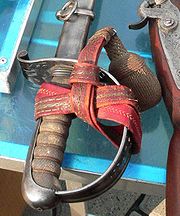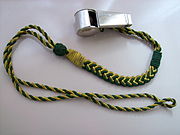
A lanyard may refer to a rope or cord worn around the neck, shoulder, or wrist to carry an object.[1] Usually it is used where there is a risk of losing the object or to ensure that it is visible at all times. Alternatively it is a length of cord or wire with a hook at the end used to fire an artillery piece, or to arm the fuze mechanism on an air-dropped bomb by pulling out a cotter pin (thereby starting the arming delay) when it leaves the aircraft.[2] Aboard a ship, it may refer to a piece of rigging used to secure or lower things (see also halyard, lines used for lifting).[3]
Origins[]

Whistle with lanyard
The earliest references to lanyards dates from 15th century France, during which the word "Lanière" was used to describe a thong or strap apparatus.[4] Later, in the French military, lanyards were used to connect a pistol, sword or whistle (for signalling) to a uniform on a semi-permanent basis. Lanyards were used in situations where there was a good chance of losing the object—commonly by cavalry and naval officers at sea. A well-made pistol lanyard can be easily removed and reattached by the user, but otherwise will stay connected to the pistol whether it is drawn or in a holster. Lanyards later became a more decorative item. A popular reference to holster lanyards is found in the 1966 Spaghetti Western The Good, The Bad, and The Ugly, in which one of the film's main characters, Tuco Ramirez, is known to carrying his pistol on a rope cord lanyard. Eli Wallach, the actor who played the part of Tuco, reportedly told director Sergio Leone that it was too difficult to put a pistol into a holster without looking, so Leone put Wallach's pistol on a lanyard.[5] Lanyards of various colour combinations and braid patterns are also commonly worn on the shoulders of military uniforms to denote the wearer's qualification or regimental affiliation.[6] Many regiments were originally mounted and wore the lanyard on the left, enabling the rider to pull a whistle from his left tunic pocket and maintain communication with his troop. Members of the British Royal Artillery wear a lanyard which originally held a key for adjusting the fuzes of explosive shells.[7]
Styles and materials[]

Lanyard for keys
The style, design or material used will vary widely depending on end-purpose of the lanyard. Common lanyard materials include polyester, nylon, satin, silk, polyethylene terephthalate (PET), braided leather or braided paracord.
Accessory for electronics[]

A USB flash drive with an Ubuntu-branded lanyard. Another feature is the black plastic part. This is a predetermined and reattachable breaking point. It is meant to prevent accidental strangulation when the lanyard is worn around the neck.
Lanyards are widely used with small electronic devices such as cameras, MP3 players and USB flash drives to prevent loss or dropping. Electronics designed to take a lanyard usually have a small through-hole built into a corner or edge of the case or anchored to the frame of the device; the corresponding lanyard generally has a loop of thread on the end that is attached to that hole with a simple knot, usually a cow hitch. Some earphones incorporate the audio signal into the lanyard, meaning it doubles up as headphone cords as well. The Wii Remote wrist strap is a form of lanyard, keeping the device attached to a player's arm during the often vigorous movements involved in its use.
Badge or identification holder[]
Lanyards are commonly used to display badges, tickets or ID cards for identification where security is required, for example, public places such as hospitals, prisons and some schools or in commercial enterprises as well as public gatherings such as concerts, conventions and trade fairs. Such lanyards would often be made of braided fabric with a clip attached to the end are used frequently in retail and business situations for holding name badges. The typical arrangement is to attach a plastic pouch with at least one clear side to the lanyard, with the person's name badge facing the front and occasionally small items such as business cards, pens or tools stashed behind the badge for easy access. Such lanyards can also be used as keychains, particularly in situations where keys can easily be lost for lack of storage, such as gyms, public pools and communal showers.
In these cases, lanyards may be customized with the related name and/or logo of the event, business, or organization. Lanyards can feature a variety of customization techniques including screen-printing, Jacquard loom weaving, heat transfer, and offset printing.
Safety strap[]
Lanyards are also often attached to dead man's switches or "kill switches" on dangerous machinery, such as large industrial cutting/slicing machines; on vehicles, such as jet-skis or trains; and on exercise treadmills, so that if the operator suddenly becomes incapacitated, their fall will pull on the lanyard attached to their wrist, which will then pull the switch to immediately stop the machine or vehicle.
Some law enforcement officers and members of the military utilize specialized lanyards to keep sidearms from falling to the ground during missions.[8]
Lineman lanyards[]
Lineman lanyards are used by Lineman utility and other workers to prevent falls, although similar straps are also used recreationally by mountain climbers. This type of lanyard will have a section of heavy duty nylon strapping attached to a metal ring or carabiner which tightens around an attachment point. The strap may be a fixed length or adjustable, and will attach to the wearer to support them against a fixed object or pole.[9]
As ornamental uniform accessories[]
Certain lanyards are still worn on uniforms as decorations. Among these are the Orange Lanyard in the Military William Order of the Netherlands, and the German Armed Forces Badge of Marksmanship.
See also[]
- Access badge
- Halyard
- Rope splicing
References[]
- ↑ "lanyard lan-yrd." Merriam-Webster's Collegiate(R) Dictionary. Springfield: Merriam-Webster, 2004. Credo Reference. Web. 1 October 2012.
- ↑ "firing lanyard." McGraw-Hill Dictionary of Scientific and Technical Terms. New York: McGraw-Hill, 2003. Credo Reference. Web. 1 October 2012.
- ↑ "lanyard lan-yrd." Merriam-Webster's Collegiate(R) Dictionary. Springfield: Merriam-Webster, 2004. Credo Reference. Web. 1 October 2012.
- ↑ "Overview of the Historical Use of Lanyards". http://www.lanyardstore.com/types-of-lanyards-history.html. Retrieved 23 March 2012.
- ↑ The Duel from The Good, The Bad and The Ugly on YouTube
- ↑ "lanyard." The Macquarie Dictionary. South Yarra: The Macquarie Library Pty Ltd., 2005. Credo Reference. Web. 1 October 2012.
- ↑ The Garrison - History and Traditions of the Royal Artillery
- ↑ "No Gear Left Behind". Tactical Gear News. 2011-04-06. http://tacticalgear.com/blog/no-gear-left-behind/.
- ↑ "Overview of the Historical Use of Lanyards". http://www.lanyardstore.com/types-of-lanyards-history.html. Retrieved 23 March 2012.
External links[]
| Wikimedia Commons has media related to Lanyards. |
| Look up lanyard in Wiktionary, the free dictionary. |
- "The Lanyard"—Poem by Billy Collins
The original article can be found at Lanyard and the edit history here.